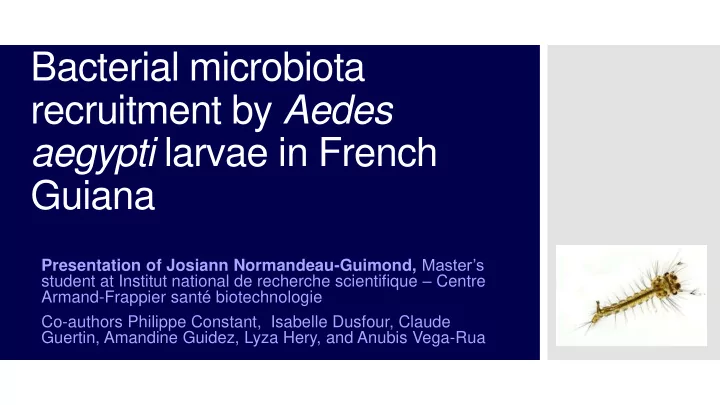

Bacterial microbiota recruitment by Aedes aegypti larvae in French Guiana Presentation of Josiann Normandeau-Guimond, Master’s student at Institut national de recherche scientifique – Centre Armand-Frappier santé biotechnologie Co-authors Philippe Constant, Isabelle Dusfour, Claude Guertin, Amandine Guidez, Lyza Hery, and Anubis Vega-Rua
A lot of functions are provided by mosquitoes’ bacterial microbiota. (Modified of Guégan, 2018)
Some genera are conserved from larvae to adults, despite the microbiota ‘’flush’’ observed at pupal stage. (Modified from M. Guégan, 2018)
α -diversity = number of species in a habitat. β -diversity = diversity of species between two habitats. Bacterial recruitment indicate all the species acquired from environment.
Our study hypothesizes that the structure of bacterial microbiota of Ae. aegypti larvae result from the structure of bacterial community in breeding sites. Hypothesis Objectives 1. Caracterization of breeding site and larvae’s microbiota. 2. Analysis of micro parameters on larvae’s structures 3. Effect of macro and meso parameters as shaping factors on bacterial microbiota of larvae
Sample collection and characterization 69 sites were choosen in French Guiana: Larvaes and water from breeding site were collected Severals pictures of each site were taken Physicochemical analysis of water (micro): pH, T°, turbidity, conductivity, O 2 dissolved … nitrite, nitrate, ammonium, calcium… Macro Micro Meso 6
Material and methods 1. Sample collection; 2. DNA extraction using PowerSoil kit; 3. Library preparation; 4. Illumina sequencing of 16S V6-V8 region ; 5. ASV file generated by USEARCH; 6. Biostatistical analysis.
Figure 2. Common bacterial genera associated with larvae and their breeding sites 31789 Novosphingobium 46562 Larvae A total of 1662 1280 Sphingopyxis 21 ASV distributed in Herbaspirillum 1913 27812 181 genera are 17 Dysgonomonas 8 2796 2590 6389 36186 Limnohabitans observed. Genera 104992 Camelimonas 13090 5331 20984 have different Breeding site Sediminibacterium proportions 52141 Brevibacillus 16530 12351 between larvae 8760 Methylobacterium 9058 14645 47089 12643 and breeding site. Polynucleobacter 10744 Bosea Acinetobacter 61212 Phreatobacter 23507 Tabrizicola 14895
Table 1. Numbers of sequences for genera found exclusively in only one environnement (larvae or breeding site.) % abundance % abundance It appears that Genera in breeding in larvae site some genera are Tessaracoccus 0.099 0.000 Paenibacillus 0.095 0.000 exclusively detect Limnobacter 0.087 0.000 Azohydromonas 0.083 0.000 in breeding site or Lactobacillus 0.076 0.000 in larvae, Oligoflexus 0.074 0.000 Parasegetibacter 0.062 0.000 suggesting a Ohtaekwangia 0.042 0.000 Brevibacterium 0.041 0.000 specifics Nocardia 0.039 0.000 recruitment. Tolumonas 0.037 0.000 Ancylobacter 0.000 1.210 Desulfovibrio 0.000 0.030 Flavihumibacter 0.000 0.021
Euclidean distance between community structure of larvae and the breeding site ranged from 30,24 to 60,84.
ASV found in water explain Canonical analysis? 55,52% of the ASV found in larvae.
Beta diversity between larvae and breeding site microbiota differ from one site to another. Breeding site microbiota seems to play a role as a shaping factor on the structure of larvae’s microbiota, but it’s not the only factor explaining it Conclusion Analysis of the effect of micro and meso parameters and on larvae’s microbiota for a better comprehension of Perspectives bacterial recruitment.
Pr Claude Guertin Narin Srei Judith Mongouong Audrey-Anne Durand Pr Philippe Constant Pr Isabelle Dusfour Amandine Guidez Pr Anubis Rua-Vega Acknowledgements Lyze Hery
Recommend
More recommend